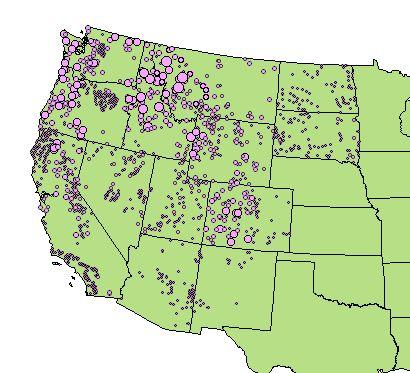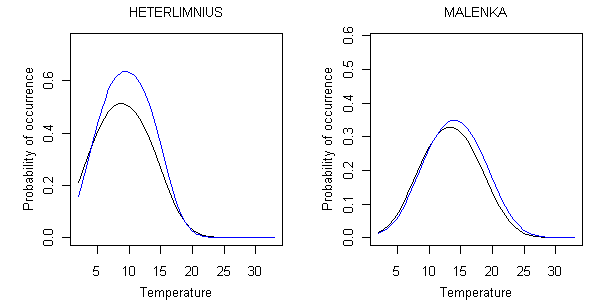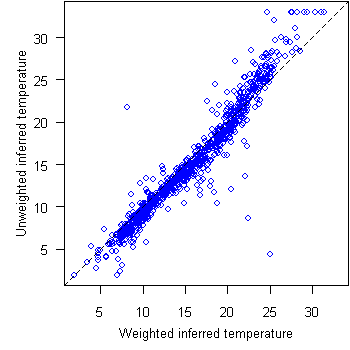Estimating Taxon-Environment Relationships: Survey Weighting
Sample data collected using probabilistic survey designs are particularly useful for estimating taxon-environment relationships because each collected sample represents a known proportion of the total length of stream in a region. Therefore, taxon-environment relationships can be developed that are truly representative of all the streams in the region. To take advantage of survey design information, it is necessary to introduce sample weights to the regressions.
 Figure 12. Map showing sample locations for EMAP-West. Size of the symbol is roughly proportional to sample weight.
Figure 12. Map showing sample locations for EMAP-West. Size of the symbol is roughly proportional to sample weight.
The length of stream each sample represents varies inEnvironmental Monitoring and Assessment (EMAP)-West because the sample design was stratified by state, so certain states with fewer streams were over-represented in the sample.
 Figure 13. Taxon-environment relationships estimated using sample weights. Blue line is weighted estimate; black line is the original estimate. Horizontal axis in units of degrees C.
Figure 13. Taxon-environment relationships estimated using sample weights. Blue line is weighted estimate; black line is the original estimate. Horizontal axis in units of degrees C.
Taking into account sample weights can have substantial effects for certain taxon-environment relationships. All previous examples shown for Heterlimnius and Malenka have been unweighted. After weighting observations in the regression model, Heterlimnius exhibited a much higher probability of capture at its optimal temperature when the regression was computed with sample weights, compared to the unweighted version. Changes to the taxon-environment relationship for Malenka were small.
 Figure 14. Comparison of weighted and unweighted inferences of stream temperature (°C). EMAP-West data used to estimate taxon-environment relationships, and inferences computed for Wyoming. Dashed line shows the 1:1 relationship.
Figure 14. Comparison of weighted and unweighted inferences of stream temperature (°C). EMAP-West data used to estimate taxon-environment relationships, and inferences computed for Wyoming. Dashed line shows the 1:1 relationship.
Taxon-environment relationships computed using weighted regressions can change the values of biological inferences. On the whole, inferences of stream temperature in Wyoming based on weighted regressions were very similar to inferences based on unweighted models. However, at certain sites the differences between weighted and unweighted models were quite large.
Incorporating survey weights into regression models provides a strong statistical basis for using data to make inferences about stream characteristics in the region. As such, if survey weights are available, they generally should be used.
